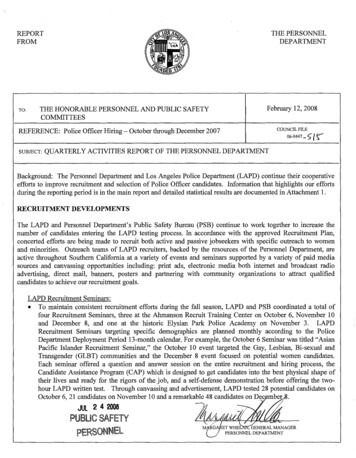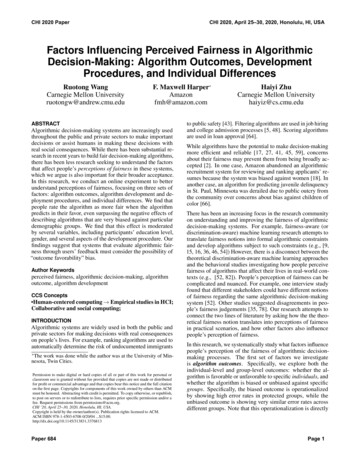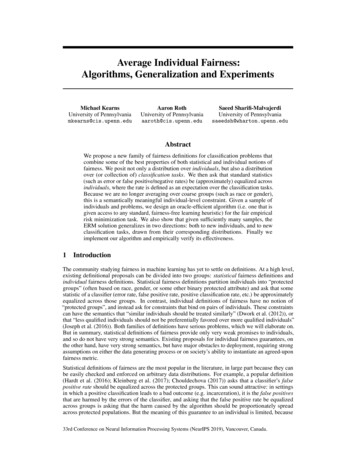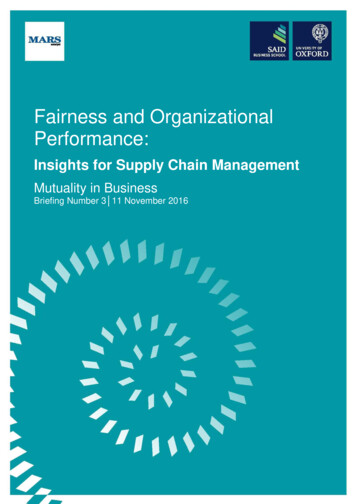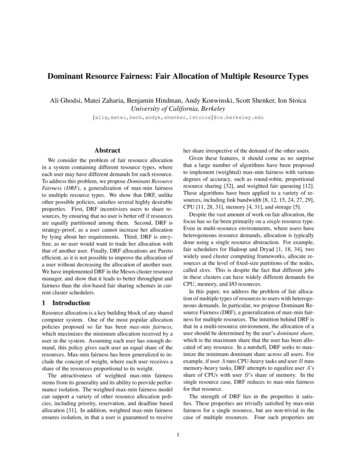
Transcription
Dominant Resource Fairness: Fair Allocation of Multiple Resource TypesAli Ghodsi, Matei Zaharia, Benjamin Hindman, Andy Konwinski, Scott Shenker, Ion StoicaUniversity of California, .berkeley.eduAbstracther share irrespective of the demand of the other users.Given these features, it should come as no surprisethat a large number of algorithms have been proposedto implement (weighted) max-min fairness with variousdegrees of accuracy, such as round-robin, proportionalresource sharing [32], and weighted fair queueing [12].These algorithms have been applied to a variety of resources, including link bandwidth [8, 12, 15, 24, 27, 29],CPU [11, 28, 31], memory [4, 31], and storage [5].Despite the vast amount of work on fair allocation, thefocus has so far been primarily on a single resource type.Even in multi-resource environments, where users haveheterogeneous resource demands, allocation is typicallydone using a single resource abstraction. For example,fair schedulers for Hadoop and Dryad [1, 18, 34], twowidely used cluster computing frameworks, allocate resources at the level of fixed-size partitions of the nodes,called slots. This is despite the fact that different jobsin these clusters can have widely different demands forCPU, memory, and I/O resources.In this paper, we address the problem of fair allocation of multiple types of resources to users with heterogeneous demands. In particular, we propose Dominant Resource Fairness (DRF), a generalization of max-min fairness for multiple resources. The intuition behind DRF isthat in a multi-resource environment, the allocation of auser should be determined by the user’s dominant share,which is the maximum share that the user has been allocated of any resource. In a nutshell, DRF seeks to maximize the minimum dominant share across all users. Forexample, if user A runs CPU-heavy tasks and user B runsmemory-heavy tasks, DRF attempts to equalize user A’sshare of CPUs with user B’s share of memory. In thesingle resource case, DRF reduces to max-min fairnessfor that resource.The strength of DRF lies in the properties it satisfies. These properties are trivially satisfied by max-minfairness for a single resource, but are non-trivial in thecase of multiple resources. Four such properties areWe consider the problem of fair resource allocationin a system containing different resource types, whereeach user may have different demands for each resource.To address this problem, we propose Dominant ResourceFairness (DRF), a generalization of max-min fairnessto multiple resource types. We show that DRF, unlikeother possible policies, satisfies several highly desirableproperties. First, DRF incentivizes users to share resources, by ensuring that no user is better off if resourcesare equally partitioned among them. Second, DRF isstrategy-proof, as a user cannot increase her allocationby lying about her requirements. Third, DRF is envyfree, as no user would want to trade her allocation withthat of another user. Finally, DRF allocations are Paretoefficient, as it is not possible to improve the allocation ofa user without decreasing the allocation of another user.We have implemented DRF in the Mesos cluster resourcemanager, and show that it leads to better throughput andfairness than the slot-based fair sharing schemes in current cluster schedulers.1IntroductionResource allocation is a key building block of any sharedcomputer system. One of the most popular allocationpolicies proposed so far has been max-min fairness,which maximizes the minimum allocation received by auser in the system. Assuming each user has enough demand, this policy gives each user an equal share of theresources. Max-min fairness has been generalized to include the concept of weight, where each user receives ashare of the resources proportional to its weight.The attractiveness of weighted max-min fairnessstems from its generality and its ability to provide performance isolation. The weighted max-min fairness modelcan support a variety of other resource allocation policies, including priority, reservation, and deadline basedallocation [31]. In addition, weighted max-min fairnessensures isolation, in that a user is guaranteed to receive1
72Per task CPU demand (cores)sharing incentive, strategy-proofness, Pareto efficiency,and envy-freeness. DRF provides incentives for users toshare resources by guaranteeing that no user is better offin a system in which resources are statically and equallypartitioned among users. Furthermore, DRF is strategyproof, as a user cannot get a better allocation by lyingabout her resource demands. DRF is Pareto-efficient asit allocates all available resources subject to satisfyingthe other properties, and without preempting existing allocations. Finally, DRF is envy-free, as no user prefersthe allocation of another user. Other solutions violate atleast one of the above properties. For example, the preferred [3, 22, 33] fair division mechanism in microeconomic theory, Competitive Equilibrium from Equal Incomes [30], is not strategy-proof.We have implemented and evaluated DRF inMesos [16], a resource manager over which multiplecluster computing frameworks, such as Hadoop and MPI,can run. We compare DRF with the slot-based fair sharing scheme used in Hadoop and Dryad and show thatslot-based fair sharing can lead to poorer performance,unfairly punishing certain workloads, while providingweaker isolation guarantees.While this paper focuses on resource allocation in datacenters, we believe that DRF is generally applicable toother multi-resource environments where users have heterogeneous demands, such as in multi-core machines.The rest of this paper is organized as follows. Section 2 motivates the problem of multi-resource fairness.Section 3 lists fairness properties that we will consider inthis paper. Section 4 introduces DRF. Section 5 presentsalternative notions of fairness, while Section 6 analyzesthe properties of DRF and other policies. Section 7 provides experimental results based on traces from a Facebook Hadoop cluster. We survey related work in Section 8 and conclude in Section 9.MapsReduces654321001457236Per task memory demand (GB)89Figure 1: CPU and memory demands of tasks in a 2000-nodeHadoop cluster at Facebook over one month (October 2010).Each bubble’s size is logarithmic in the number of tasks in itsregion.heavy as well, especially for reduce operations.Existing fair schedulers for clusters, such as Quincy[18] and the Hadoop Fair Scheduler [2, 34], ignore theheterogeneity of user demands, and allocate resources atthe granularity of slots, where a slot is a fixed fractionof a node. This leads to inefficient allocation as a slot ismore often than not a poor match for the task demands.Figure 2 quantifies the level of fairness and isolation provided by the Hadoop MapReduce fair scheduler [2, 34]. The figure shows the CDFs of the ratiobetween the task CPU demand and the slot CPU share,and of the ratio between the task memory demand andthe slot memory share. We compute the slot memoryand CPU shares by simply dividing the total amount ofmemory and CPUs by the number of slots. A ratio of1 corresponds to a perfect match between the task demands and slot resources, a ratio below 1 corresponds totasks underutilizing their slot resources, and a ratio above1 corresponds to tasks over-utilizing their slot resources,which may lead to thrashing. Figure 2 shows that most ofthe tasks either underutilize or overutilize some of theirslot resources. Modifying the number of slots per machine will not solve the problem as this may result eitherin a lower overall utilization or more tasks experiencingpoor performance due to over-utilization (see Section 7).MotivationWhile previous work on weighted max-min fairness hasfocused on single resources, the advent of cloud computing and multi-core processors has increased the needfor allocation policies for environments with multipleresources and heterogeneous user demands. By multiple resources we mean resources of different types, instead of multiple instances of the same interchangeableresource.To motivate the need for multi-resource allocation, weplot the resource usage profiles of tasks in a 2000-nodeHadoop cluster at Facebook over one month (October2010) in Figure 1. The placement of a circle in Figure 1indicates the memory and CPU resources consumed bytasks. The size of a circle is logarithmic to the number oftasks in the region of the circle. Though the majority oftasks are CPU-heavy, there exist tasks that are memory-3Allocation PropertiesWe now turn our attention to designing a max-min fair allocation policy for multiple resources and heterogeneousrequests. To illustrate the problem, consider a systemconsisting of 9 CPUs and 18 GB RAM, and two users:user A runs tasks that require h1 CPUs, 4 GBi each, anduser B runs tasks that require h3 CPUs, 1 GBi each.What constitutes a fair allocation policy for this case?2
1.0with indicates that strategy-proofness is important, as itis common for users to attempt to manipulate schedulers.For example, one of Yahoo!’s Hadoop MapReduce datacenters has different numbers of slots for map and reduce tasks. A user discovered that the map slots werecontended, and therefore launched all his jobs as longreduce phases, which would manually do the work thatMapReduce does in its map phase. Another big searchcompany provided dedicated machines for jobs only ifthe users could guarantee high utilization. The companysoon found that users would sprinkle their code with infinite loops to artificially inflate utilization levels.Furthermore, any policy that satisfies the sharing incentive property also provides performance isolation, asit guarantees a minimum allocation to each user (i.e., auser cannot do worse than owning n1 of the cluster) irrespective of the demands of the other users.It can be easily shown that in the case of a single resource, max-min fairness satisfies all the above properties. However, achieving these properties in the caseof multiple resources and heterogeneous user demandsis not trivial. For example, the preferred fair divisionmechanism in microeconomic theory, Competitive Equilibrium from Equal Incomes [22, 30, 33], is not strategyproof (see Section 6.1.2).In addition to the above properties, we consider fourother nice-to-have properties:CDF of tasks0.80.60.40.20.00.0Memory demandCPU demand1.50.51.02.0Ratio of task demand to resource per slot2.5Figure 2: CDF of demand to slot ratio in a 2000-node cluster atFacebook over a one month period (October 2010). A demandto slot ratio of 2.0 represents a task that requires twice as muchCPU (or memory) than the slot CPU (or memory) size.One possibility would be to allocate each user half ofevery resource. Another possibility would be to equalize the aggregate (i.e., CPU plus memory) allocations ofeach user. While it is relatively easy to come up with avariety of possible “fair” allocations, it is unclear how toevaluate and compare these allocations.To address this challenge, we start with a set of desirable properties that we believe any resource allocation policy for multiple resources and heterogeneous demands should satisfy. We then let these properties guidethe development of a fair allocation policy. We havefound the following four properties to be important: Single resource fairness: For a single resource, thesolution should reduce to max-min fairness.1. Sharing incentive: Each user should be better offsharing the cluster, than exclusively using her ownpartition of the cluster. Consider a cluster with identical nodes and n users. Then a user should not beable to allocate more tasks in a cluster partition consisting of n1 of all resources. Bottleneck fairness: If there is one resource that ispercent-wise demanded most of by every user, thenthe solution should reduce to max-min fairness forthat resource. Population monotonicity: When a user leaves thesystem and relinquishes her resources, none of theallocations of the remaining users should decrease.2. Strategy-proofness: Users should not be able tobenefit by lying about their resource demands. Thisprovides incentive compatibility, as a user cannotimprove her allocation by lying. Resource monotonicity: If more resources are addedto the system, none of the allocations of the existingusers should decrease.3. Envy-freeness: A user should not prefer the allocation of another user. This property embodies thenotion of fairness [13, 30].4Dominant Resource Fairness (DRF)We propose Dominant Resource Fairness (DRF), a newallocation policy for multiple resources that meets allfour of the required properties in the previous section.For every user, DRF computes the share of each resourceallocated to that user. The maximum among all sharesof a user is called that user’s dominant share, and theresource corresponding to the dominant share is calledthe dominant resource. Different users may have different dominant resources. For example, the dominantresource of a user running a computation-bound job is4. Pareto efficiency: It should not be possible to increase the allocation of a user without decreasingthe allocation of at least another user. This property is important as it leads to maximizing systemutilization subject to satisfying the other properties.We briefly comment on the strategy-proofness andsharing incentive properties, which we believe are ofspecial importance in datacenter environments. Anecdotal evidence from cloud operators that we have talked3
User A100%3 CPUsAlgorithm 1 DRF pseudo-codeUser BR hr1 , · · · , rm i. total resource capacitiesC hc1 , · · · , cm i . consumed resources, initially 0si (i 1.n) . user i’s dominant shares, initially 0Ui hui,1 , · · · , ui,m i (i 1.n) . resources given touser i, initially 012 GB50%0%6 CPUsCPUs(9 total)pick user i with lowest dominant share siDi demand of user i’s next taskif C Di R thenC C Di. update consumed vectorUi Ui Di. update i’s allocation vectorsi maxmj 1 {ui,j /rj }elsereturn. the cluster is fullend if2 GBMemory(18GB total)Figure 3: DRF allocation for the example in Section 4.1.CPU, while the dominant resource of a user running anI/O-bound job is bandwidth.1 DRF simply applies maxmin fairness across users’ dominant shares. That is, DRFseeks to maximize the smallest dominant share in thesystem, then the second-smallest, and so on.We start by illustrating DRF with an example (§4.1),then present an algorithm for DRF (§4.2) and a definition of weighted DRF (§4.3). In Section 5, we presenttwo other allocation policies: asset fairness, a straightforward policy that aims to equalize the aggregate resourcesallocated to each user, and competitive equilibrium fromequal incomes (CEEI), a popular fair allocation policypreferred in the micro-economic domain [22, 30, 33].In this section, we consider a computation model withn users and m resources. Each user runs individual tasks,and each task is characterized by a demand vector, whichspecifies the amount of resources required by the task,e.g., h1 CPU, 4 GBi. In general, tasks (even the onesbelonging to the same user) may have different demands.4.1by DRF to users A and B, respectively. Then user Areceives hx CPU, 4x GBi, while user B gets h3y CPU,y GBi. The total amount of resources allocated to bothusers is (x 3y) CPUs and (4x y) GB. Also, the dominant shares of users A and B are 4x/18 2x/9 and3y/9 y/3, respectively (their corresponding shares ofmemory and CPU). The DRF allocation is then given bythe solution to the following optimization problem:max (x, y)(Maximize allocations)subject toAn Examplex 3y 9 (CPU constraint)4x y2x9 18 (Memory constraint)y(Equalize dominant shares)3 Solving this problem yields2 x 3 and y 2. Thus,user A gets h3 CPU, 12 GBi and B gets h6 CPU, 2 GBi.Note that DRF need not always equalize users’ dominant shares. When a user’s total demand is met, that userwill not need more tasks, so the excess resources willbe split among the other users, much like in max-minfairness. In addition, if a resource gets exhausted, usersthat do not need that resource can still continue receiving higher shares of the other resources. We present analgorithm for DRF allocation in the next section.Consider a system with of 9 CPUs, 18 GB RAM, and twousers, where user A runs tasks with demand vector h1CPU, 4 GBi, and user B runs tasks with demand vectorh3 CPUs, 1 GBi each.In the above scenario, each task from user A consumes1/9 of the total CPUs and 2/9 of the total memory, souser A’s dominant resource is memory. Each task fromuser B consumes 1/3 of the total CPUs and 1/18 of thetotal memory, so user B’s dominant resource is CPU.DRF will equalize users’ dominant shares, giving the allocation in Figure 3: three tasks for user A, with a totalof h3 CPUs, 12 GBi, and two tasks for user B, with atotal of h6 CPUs, 2 GBi. With this allocation, each userends up with the same dominant share, i.e., user A gets2/3 of RAM, while user B gets 2/3 of the CPUs.This allocation can be computed mathematically asfollows. Let x and y be the number of tasks allocated4.2DRF Scheduling AlgorithmAlgorithm 1 shows pseudo-code for DRF scheduling.The algorithm tracks the total resources allocated to eachuser as well as the user’s dominant share, si . At eachstep, DRF picks the user with the lowest dominant shareamong those with tasks ready to run. If that user’s taskdemand can be satisfied, i.e., there are enough resources1A2 Notethat given last constraint (i.e., 2x/9 y/3) allocations xand y are simultaneously maximized.user may have the same share on multiple resources, and mighttherefore have multiple dominant resources.4
ScheduleUser BUser AUser AUser BUser AUser Ares. sharesdom. shareh0, 0i0h1/9, 4/18i2/9h2/9, 8/18i4/9h2/9, 8/18i4/9h3/9, 12/18i2/3User Bres. sharesdom. shareh3/9, 1/18i1/3h3/9, 1/18i1/3h3/9, 1/18i1/3h6/9, 2/18i2/3h6/9, 2/18i2/3CPUtotal alloc.3/94/95/98/91RAMtotal alloc.1/185/189/1810/1814/18Table 1: Example of DRF allocating resources in a system with 9 CPUs and 18 GB RAM to two users running tasks that requireh1 CPU, 4 GBi and h3 CPUs, 1 GBi, respectively. Each row corresponds to DRF making a scheduling decision. A row shows theshares of each user for each resource, the user’s dominant share, and the fraction of each resource allocated so far. DRF repeatedlyselects the user with the lowest dominant share (indicated in bold) to launch a task, until no more tasks can be allocated.case of interest is when all the weights of user i are equal,i.e., wi,j wi , (1 j m). In this case, the ratio between the dominant shares of users i and j will be simplywi /wj . If the weights of all users are set to 1, WeightedDRF reduces trivially to DRF.available in the system, one of her tasks is launched. Weconsider the general case in which a user can have taskswith different demand vectors, and we use variable Di todenote the demand vector of the next task user i wantsto launch. For simplicity, the pseudo-code does not capture the event of a task finishing. In this case, the userreleases the task’s resources and DRF again selects theuser with the smallest dominant share to run her task.Consider the two-user example in Section 4.1. Table 1illustrates the DRF allocation process for this example.DRF first picks B to run a task. As a result, the sharesof B become h3/9, 1/18i, and the dominant share becomes max(3/9, 1/18) 1/3. Next, DRF picks A, asher dominant share is 0. The process continues until itis no longer possible to run new tasks. In this case, thishappens as soon as CPU has been saturated.At the end of the above allocation, user A gets h3 CPU,12 GBi, while user B gets h6 CPU, 2 GBi, i.e., each usergets 2/3 of its dominant resource.Note that in this example the allocation stops as soonas any resource is saturated. However, in the generalcase, it may be possible to continue to allocate tasks evenafter some resource has been saturated, as some tasksmight not have any demand on the saturated resource.The above algorithm can be implemented using a binary heap that stores each user’s dominant share. Eachscheduling decision then takes O(log n) time for n users.4.35Alternative Fair Allocation PoliciesDefining a fair allocation in a multi-resource system isnot an easy question, as the notion of “fairness” is itselfopen to discussion. In our efforts, we considered numerous allocation policies before settling on DRF as the onlyone that satisfies all four of the required properties inSection 3: sharing incentive, strategy-proofness, Paretoefficiency, and envy-freeness. In this section, we consider two of the alternatives we have investigated: AssetFairness, a simple and intuitive policy that aims to equalize the aggregate resources allocated to each user, andCompetitive Equilibrium from Equal Incomes (CEEI),the policy of choice for fairly allocating resources in themicroeconomic domain [22, 30, 33]. We compare thesepolicies with DRF in Section 5.3.5.1Asset FairnessThe idea behind Asset Fairness is that equal shares ofdifferent resources are worth the same, i.e., that 1% ofall CPUs worth is the same as 1% of memory and 1%of I/O bandwidth. Asset Fairness then tries to equalizethe aggregate resource value allocated to each user. Inparticular, Asset FairnessP computes for each user i theaggregate share xi j si,j , where si,j is the share ofresource j given to user i. It then applies max-min acrossusers’ aggregate shares, i.e., it repeatedly launches tasksfor the user with the minimum aggregate share.Consider the example in Section 4.1. Since there aretwice as many GB of RAM as CPUs (i.e., 9 CPUs and18 GB RAM), one CPU is worth twice as much as oneGB of RAM. Supposing that one GB is worth 1 andone CPU is worth 2, it follows that user A spends 6for each task, while user B spends 7. Let x and y bethe number of tasks allocated by Asset Fairness to usersA and B, respectively. Then the asset-fair allocation isWeighted DRFIn practice, there are many cases in which allocating resources equally across users is not the desirable policy.Instead, we may want to allocate more resources to usersrunning more important jobs, or to users that have contributed more resources to the cluster. To achieve thisgoal, we propose Weighted DRF, a generalization of bothDRF and weighted max-min fairness.With Weighted DRF, each user i is associated a weightvector Wi hwi,1 , . . . , wi,m i, where wi,j represents theweight of user i for resource j. The definition of a dominant share for user i changes to si maxj {ui,j /wi,j },where ui,j is user i’s share of resource j. A particular5
given by the solution to the following optimization problem:max (x, y)User AUser B100%100%100%50%50%50%(Maximize allocations)subject tox 3y 9 (CPU constraint)4x y 18 (Memory constraint)6x 7y (Every user spends the same)Solving the above problem yields x 2.52 and y 2.16. Thus, user A gets h2.5 CPUs, 10.1 GBi, while userB gets h6.5 CPUs, 2.2 GBi, respectively.While this allocation policy seems compelling in itssimplicity, it has a significant drawback: it violates thesharing incentive property. As we show in Section 6.1.1,asset fairness can result in one user getting less than 1/nof all resources, where n is the total number of users.5.20%a) DRF0%CPU Memb) Asset Fairness0%CPU Memc) CEEIFigure 4: Allocations given by DRF, Asset Fairness and CEEIin the example scenario in Section 4.1.Unfortunately, while CEEI is envy-free and Pareto efficient, it turns out that it is not strategy-proof, as we willshow in Section 6.1.2. Thus, users can increase their allocations by lying about their resource demands.Competitive Equilibrium from Equal IncomesIn microeconomic theory, the preferred method to fairlydivide resources is Competitive Equilibrium from EqualIncomes (CEEI) [22, 30, 33]. With CEEI, each user receives initially n1 of every resource, and subsequently,each user trades her resources with other users in a perfectly competitive market.3 The outcome of CEEI is bothenvy-free and Pareto efficient [30].More precisely, the CEEI allocation is given by theNash bargaining solution4 [22, 23]. The Nash bargainingQ solution picks the feasible allocation that maximizesi ui (ai ), where ui (ai ) is the utility that user i gets fromher allocation ai . To simplify the comparison, we assumethat the utility that a user gets from her allocation is simply her dominant share, si .Consider again the two-user example in Section 4.1.Recall that the dominant share of user A is 4x/18 2x/9 while the dominant share of user B is 3y/9 y/3,where x is the number of tasks given to A and y is thenumber of tasks given to B. Maximizing the productof the dominant shares is equivalent to maximizing theproduct x · y. Thus, CEEI aims to solve the followingoptimization problem:max (x · y)CPU Mem5.3Comparison with DRFTo give the reader an intuitive understanding of AssetFairness and CEEI, we compare their allocations for theexample in Section 4.1 to that of DRF in Figure 4.We see that DRF equalizes the dominant shares of theusers, i.e., user A’s memory share and user B’s CPUshare. In contrast, Asset Fairness equalizes the total fraction of resources allocated to each user, i.e., the areas ofthe rectangles for each user in the figure. Finally, because CEEI assumes a perfectly competitive market, itfinds a solution satisfying market clearance, where every resource has been allocated. Unfortunately, this exact property makes it possible to cheat CEEI: a user canclaim she needs more of some underutilized resourceeven when she does not, leading CEEI to give more tasksoverall to this user to achieve market clearance.6AnalysisIn this section, we discuss which of the properties presented in Section 3 are satisfied by Asset Fairness, CEEI,and DRF. We also evaluate the accuracy of DRF whentask sizes do not match the available resources exactly.(maximize Nash product)subject tox 3y 9 (CPU constraint)6.14x y 18 (Memory constraint)Table 2 summarizes the fairness properties that are satisfied by Asset Fairness, CEEI, and DRF. The Appendixcontains the proofs of the main properties of DRF, whileour technical report [14] contains a more complete list ofresults for DRF and CEEI. In the remainder of this section, we discuss some of the interesting missing entriesin the table, i.e., properties violated by each of these disciplines. In particular, we show through examples whyAsset Fairness and CEEI lack the properties that theySolving the above problem yields x 45/11 and y 18/11. Thus, user A gets h4.1 CPUs, 16.4 GBi, whileuser B gets h4.9 CPUs, 1.6 GBi.3 A perfect market satisfies the price-taking (i.e., no single user affects prices) and market-clearance (i.e., matching supply and demandvia price adjustment) assumptions.4 For this to hold, utilities have to be homogeneous, i.e., u(α x) α u(x) for α 0, which is true in our case.6Fairness Properties
PropertySharing IncentiveStrategy-proofnessEnvy-freenessPareto efficiencySingle Resource FairnessBottleneck FairnessPopulation MonotonicityResource MonotonicityAllocation PolicyAsset CEEI DRFXXXXXXXXXXXXXXXXXUser 1User 2Resource 1Resource 2100%50%0%Figure 5: Example showing that Asset Fairness can fail to meetthe sharing incentive property. Asset Fairness gives user 2 lessthan half of both resources.Table 2: Properties of Asset Fairness, CEEI and DRF.User 2User 1do, and we prove that no policy can provide resourcemonotonicity without violating either sharing incentiveor Pareto efficiency to explain why DRF lacks resourcemonotonicity.6.1.1100%100%50%50%Properties Violated by Asset FairnessWhile being the simplest policy, Asset Fairness violatesseveral important properties: sharing incentive, bottleneck fairness, and resource monotonicity. Next, we useexamples to show the violation of these properties.0%Res. 1 Res. 2a) With truthfuldemandsTheorem 1 Asset Fairness violates the sharing incentive property.0%Res. 1 Res. 2b) With user 1lyingFigure 6: Example showing how CEEI violates strategy proofness. User 1 can increase her share by claiming that she needsmore of resource 2 than she actually does.Proof Consider the following example, illustrated inFigure 5: two users in a system with h30, 30i total resources have demand vectors D1 h1, 3i, and D2 h1, 1i. Asset fairness will allocate the first user 6 tasksand the second user 12 tasks. The first user will receiveh6, 18i resources, while the second will use h12, 12i.24While each user gets an equal aggregate share of 60, thesecond user gets less than half (15) of both resources.This violates the sharing incentive property, as the second user would be better off to statically partition thecluster and own half of the nodes. Proof Consider two users A and B with demands h4, 2iand h1, 1i and 77 units of two resources. Asset fairnessallocates A a total of h44, 22i and B h33, 33i equalizing66their sum of shares to 77. If resource two is doubled, bothusers’ share of the second resource is halved, while thefirst resource is saturated. Asset fairness now decreasesA’s allocation to h42, 21i and increases B’s to h35, 35i,213535105equalizing their shares to 4277 154 77 154 154 .Thus resource monotonicity is violated. 6.1.2Theorem 2 Asset Fairness violates the bottleneck fairness property.Properties Violated by CEEIProof Consider a scenario with a total resource vector ofh21, 21i and two users with demand vectors D1 h3, 2iand D2 h4, 1i, making resource 1 the bottleneck resource. Asset fairness will give each user 3 tasks, equalizing their aggregate usage to 15. However, this onlygives the first user 73 of resource 1 (the contended bottleneck resource), violating bottleneck fairness. While CEEI is envy-free and Pareto efficient, it turnsout that it is not strategy proof. Intuitively, this is because CEEI assumes a perfectly competitive market thatachieves market clearance, i.e., matching of supply anddemand and allocation of all the available res
the properties of DRF and other policies. Section 7 pro-vides experimental results based on traces from a Face-book Hadoop cluster. We survey related work in Sec-tion 8 and conclude in Section 9. 2 Motivation While previous work on weighted max-min fairness has focused on single resources, the advent of cloud com-

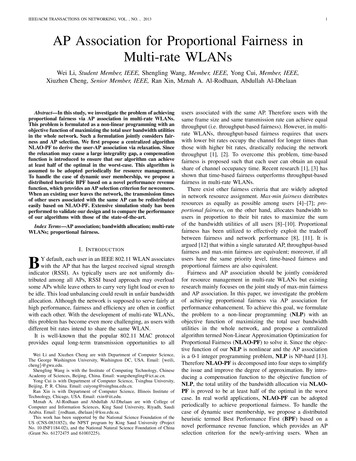

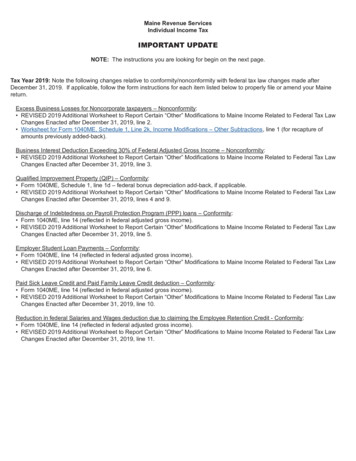
![[Title to come] DSP Dynamic Asset Allocation Fund](/img/24/dsp-dynamic-asset-allocation-fund.jpg)
